May 21, 2025 | 00:08 GMT +7
May 21, 2025 | 00:08 GMT +7
Hotline: 0913.378.918
May 21, 2025 | 00:08 GMT +7
Hotline: 0913.378.918
Within the framework of the first Da River Shrimp and Fish Festival in Hoa Binh province, the agricultural fair and OCOP product exhibition in the Northern Midlands and Mountains region in 2023, MARD coordinated with the People’s Committee of Hoa Binh province to organize the Conference on Economic Development of Reservoir Fisheries.

According to Deputy Minister Phung Duc Tien, the potential and space for developing the reservoir fisheries area is full. Photo: Trung Quan.
According to the Department of Irrigation, the country has more than 6,700 irrigation reservoirs with a total storage capacity of about 14.5 billion cubic meters. The State invests in reservoirs to store water for year-round production and regulate flood water. Clean water sources in reservoirs are favorable conditions for fisheries to develop.
Statistics from the Department of Fisheries also show that the country has more than 1,200 reservoirs with aquaculture activities in the lake bed. The whole country has 13 reservoirs with an area of over 5,000 hectares, of which Hoa Binh, Son La, Na Hang (Tuyen Quang), Thac Ba (Yen Bai), Tri An (Dong Nai) have potential reservoirs and the ability to develop fisheries in a commodity-oriented, responsible, and sustainable manner. Plei-Krong, Yaly, Se San 4, Dong Nai 3, Lai Chau, Ban Chat, and Thac Mo lakes belong to the group of reservoirs with average aquaculture potential.
In 23 provinces with the potential for developing reservoir fisheries, there are currently more than 29,000 fish cages. Reservoir aquaculture output in the first nine months of 2023 is estimated to reach more than 36,400 tons (102% over the same period and 100% of the plan).
Taking advantage of the water surface from reservoirs along with methodical and scientific investment will help freshwater aquaculture activities in the reservoir thrive. This contributes significantly to the local socio-economic development, creating jobs, ensuring nutritional security, developing tourism, increasing people’s income, and contributing to hunger eradication and poverty reduction.
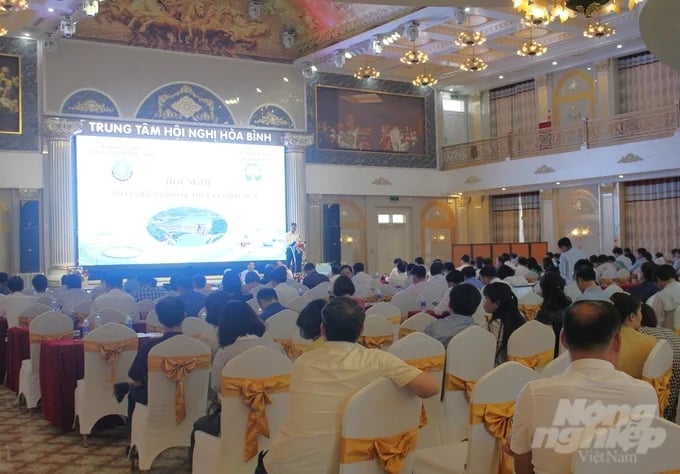
At the conference, delegates shared the difficulties and obstacles that reservoir fisheries are facing. Photo: Trung Quan.
At the conference, delegates agreed that the country’s potential for developing aquaculture in irrigation and hydroelectric reservoirs is enormous. However, the water surface area for aquaculture is still limited because the implementation process still faces difficulties and obstacles.
Specifically, in terms of management, a water reservoir is an irrigation project that serves multiple purposes, ensuring harmony between development and protecting natural resources. However, aquaculture is an activity within the protection scope of irrigation works that must be licensed (the licensing authority belongs to the Provincial People’s Committee). Procedures and licensing documents according to Articles 13, 14, 15, 16, 17, 21, and 22 of Decree 67/2018/ND-CP (dated May 14, 2018 of the Government) detail a number of articles of Irrigation Law. Besides, according to Article 47, Irrigation Law, to be licensed, this activity must be included in the approved irrigation planning. But up to now, most localities have not approved plans to add aquaculture content to reservoirs.
According to regulations on conditions for aquaculture facilities, the location of aquaculture facilities must comply with regulations on land use for aquaculture according to the provisions of the law. However, most reservoirs have not been granted land or water surface use rights, causing difficulties in licensing aquaculture in the reservoir.
The main task of reservoirs is to store water for agricultural production and flood regulation. During the dry season, many reservoirs have shallow water levels, greatly affecting aquaculture. During the flood season, when the lake water level rises, it usually overflows, and aquatic products will follow the flow downstream. If a barrier is used, it will obstruct the flow, making the project unsafe.
Regarding infrastructure, most reservoirs are located in remote areas with difficult transportation. There is no electricity system to serve intensive and semi-intensive fish farming. Some fish cage farming areas must use electricity from households near the area, causing difficulties in production. Industrial cages use iron, stainless steel, and HDPE materials, while every year they are greatly affected by storms and floods.
Raising fish in cages in reservoirs is still spontaneous and has not been concentrated in a specialized farming area, so it cannot create a safe farming area. There is no policy to encourage and attract economic sectors and businesses to invest in aquaculture at the reservoir.
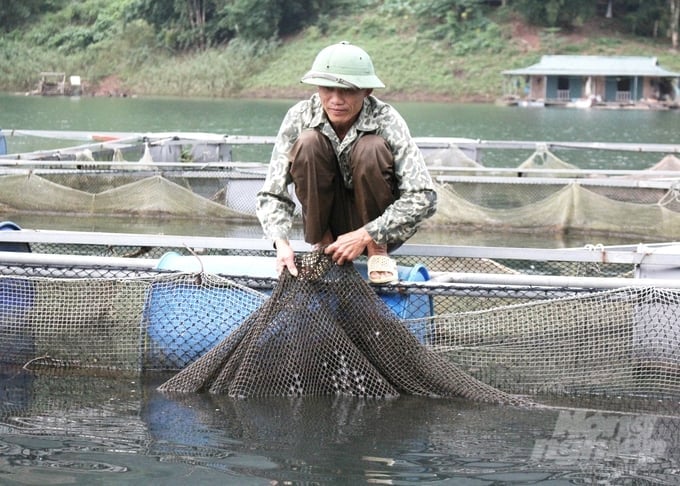
Lake fish farming households need to diversify farming species to meet the products the market needs and aim for export. Photo: Trung Quan.
Specific aquaculture planning for each reservoir
MARD Deputy Minister Phung Duc Tien emphasized that the fisheries industry is developing in the direction of reducing exploitation rates and increasing aquaculture rates. However, if we only rely on marine farming alone, the set goals will be very difficult to achieve. The requirement is to diversify economically valuable farming species in salty, fresh, and brackish water.
The Deputy Minister also assessed that the potential for developing reservoir fisheries is still full. If exploited well, a lake aquaculture industry can be formed.
Therefore, units and localities have identified difficulties and problems that need to be urgently implemented to overcome them. In particular, provinces focus on encouraging people to promote the application of advanced science and technology in production, transparent information to trace product origin and develop responsible and sustainable production activities. Besides, diversifying farming objects shall meet the products the market needs and aims to export.
Research units continue to create new sets of quality to serve production needs, upgrade and create new types of nutritious food to increase product quality, and protect the farming environment.
Specialized and local management agencies will urgently review, evaluate, and develop specific development plans and projects for each reservoir and indicate which lakes can be exploited for multi-value or single-value. At the same time, they will build mechanisms and policies to encourage the formation of linked chains in product consumption, especially to attract businesses to participate in the deep processing of reservoir fisheries.
Translated by Quynh Chi

(VAN) In 2024, over 295 million people across 53 countries and territories faced acute hunger—an increase of almost 14 million people compared to 2023, while the number of people facing catastrophic levels of hunger reached a record high.

(VAN) World Environment Day 2025 (June 5) carries the theme 'Beat Plastic Pollution' continuing to emphasize the global urgency of addressing the plastic waste crisis.

(VAN) This was the assessment shared by experts at the workshop titled 'Assessing the Role and Potential of Low-Emission Rice Production Systems in Vietnam,' held on the morning of May 19.

(VAN) Cai Rong Port is the fisheries control center of Quang Ninh, helping to monitor fishing vessels, combat IUU fishing, and remove the EC's 'yellow card'.
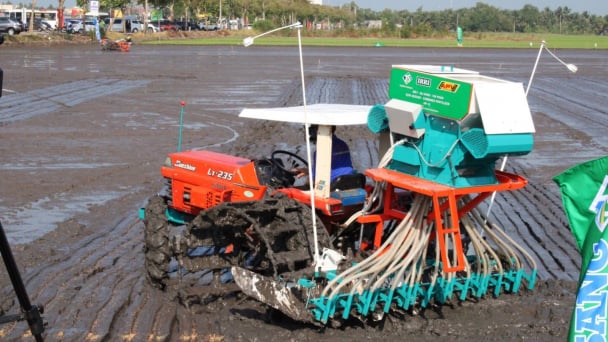
(VAN) The German Agricultural Society (DLG) explores the possibility of establishing a mechanization service center in Vietnam’s Mekong Delta to support farmers in accessing and utilizing advanced machinery.
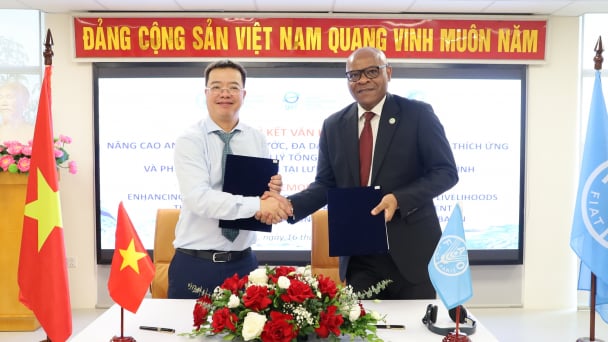
(VAN) On May 16, the Department of Water Resources Management, in collaboration with the Food and Agriculture Organization of the United Nations (FAO), held a signing ceremony for the GEF-8 project document.
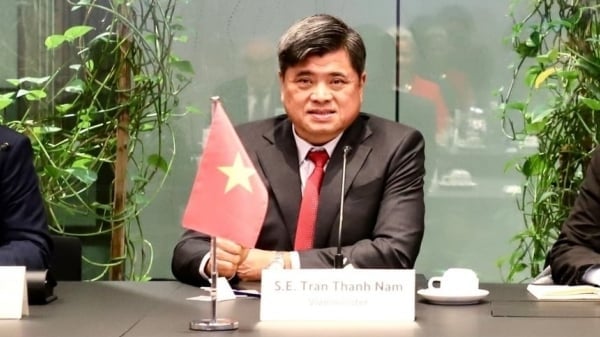
(VAN) Food safety, mechanization, vocational training, and market opening are key areas of cooperation expected between the Vietnamese Government and the Federal Republic of Germany.